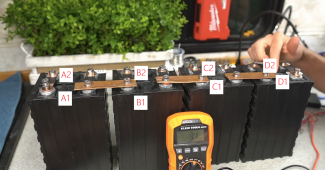When you do a 2p4s config (ie 4-pair of cells with each pair in parallel and then the pairs connected in series which allows you can use a single BMS to achieve a 400A, 12V pack. However, the BMS will NOT be able to balance below the pair level as from it's perspective each pair is a SINGLE cell. In a 2P4S config if there is a weak or failing cell in a pair, the pair appears as a bad cell to the BMS. That is why it is REALLY important that you fully characterize EVERY cell so as to match them as closely as possible in the beginning. You COULD initially build it as a 8S pack (ie 24V) and allow the BMS to balance them at the TOP END using an external bench power supply. This way you can SEE if any cells exhibit issues. Investing in a battery internal resistance meter, such as the YR1035+ ($50) on AliExpress, allows your to match them based on internal resistance and to find any wayward cells before assembling a pack. Assume NOTHING, ONLY hard data matters. If you are lucky enough to have 8 reasonable matched cells, then disassemble and reassemble as a 2P4S.
Another way is to build 2 separate 4S packs, each with its own BMS (BOTH BMSes need to have the same ratings) and then parallel them. Since you want 2000W you need ensure that EITHER pack can delivery the full 2000W/166+ amps should either pack's BMS disconnect for an over/under condition. As is ALWAYS good practice, each 4S pack needs a fast blow fuse between its positive and ANY charger/loads. DO NOT depend on the BMS to act as your fuse! In a 12V pack, you can use either a T-class OR marine MRBF fuses. Beyond 12V packs require T-Class fuses. I chose MRBF as they are more compact and @ 12V have the same interrupting current rating as a T-Class and they are less expensive (not to be confused with cheap).
There is a 3rd way where you build it permanently as an 8S, single BMS, 24V pack and then use a DC-DC power converter to drop the voltage to 12V for your camper 12V systems while running your 120VAC inverter directly from 24V. This reduces the wiring size requirement as the amps out of the battery itself are cut in half due to the voltage doubling. However, this means that you also need a DC-DC LiFePO4 specific charger to take the 12V from your van and step it up to the 24V needed to charge the pack as well as a 24V output shore power charger. So more electronics/cost but there are advantages none the less. I heavily considered this approach but the cost/benefit was marginal at best, so I went with the dual 12V packs in parallel. FYI, As I have a generator, my setup does NOT include an inverter so the loads in my 34ft Airstream are under 60As total.
I know it seems very overwhelming. As a retired EE, I know all too well the complexities. What you have to remember is you are creating a device regardless of how you configure it with more than enough contained energy to do real damage in a failure, so safety has to be JOB 1 regardless of cost! Going cheap is NOT a good approach to these high capacity LiFePO4 systems.
FYI, I found some excellent flexible (braided wire/ solid ends) busbars on eBay. Not exactly cheap, but really well made and more than capable of 200A.
david




